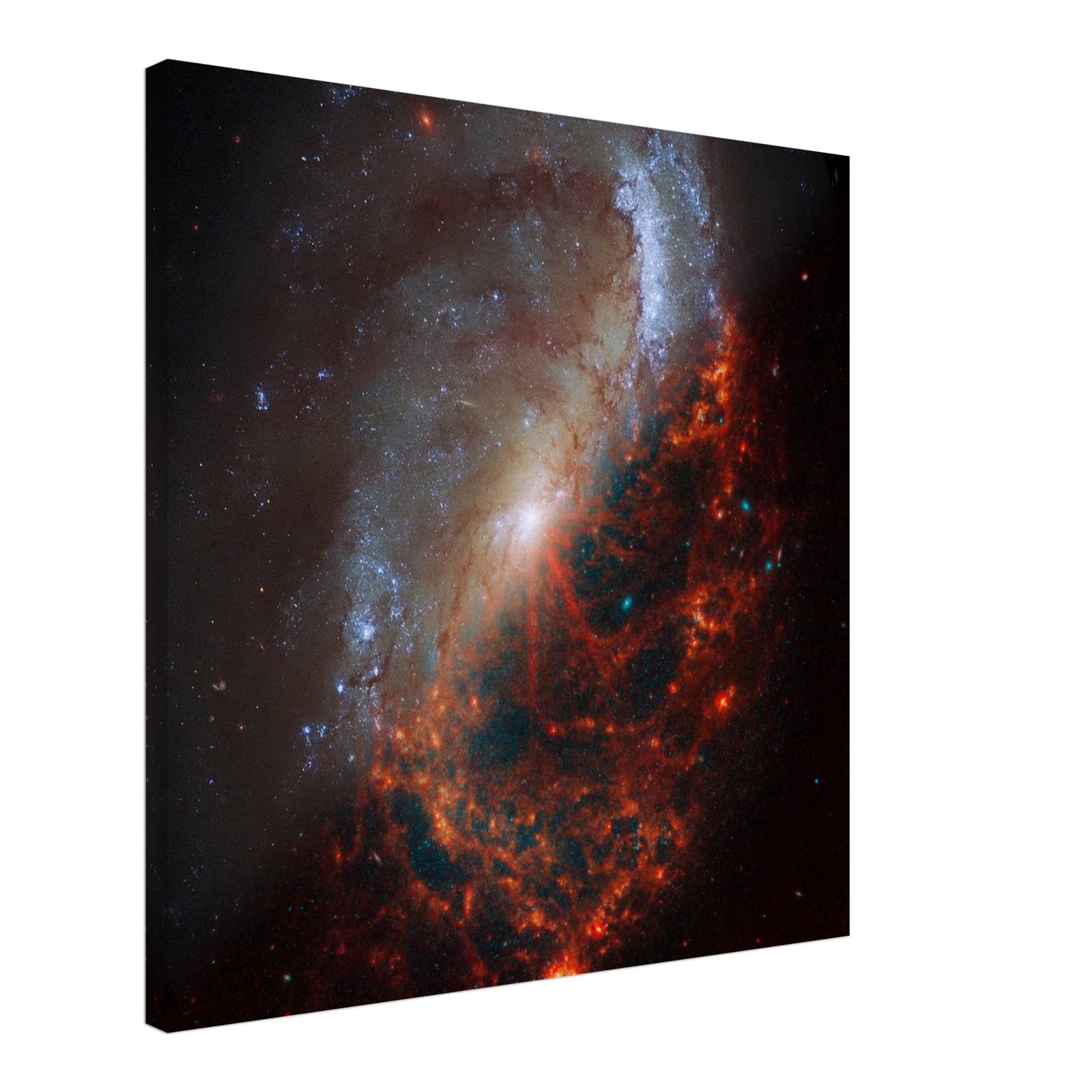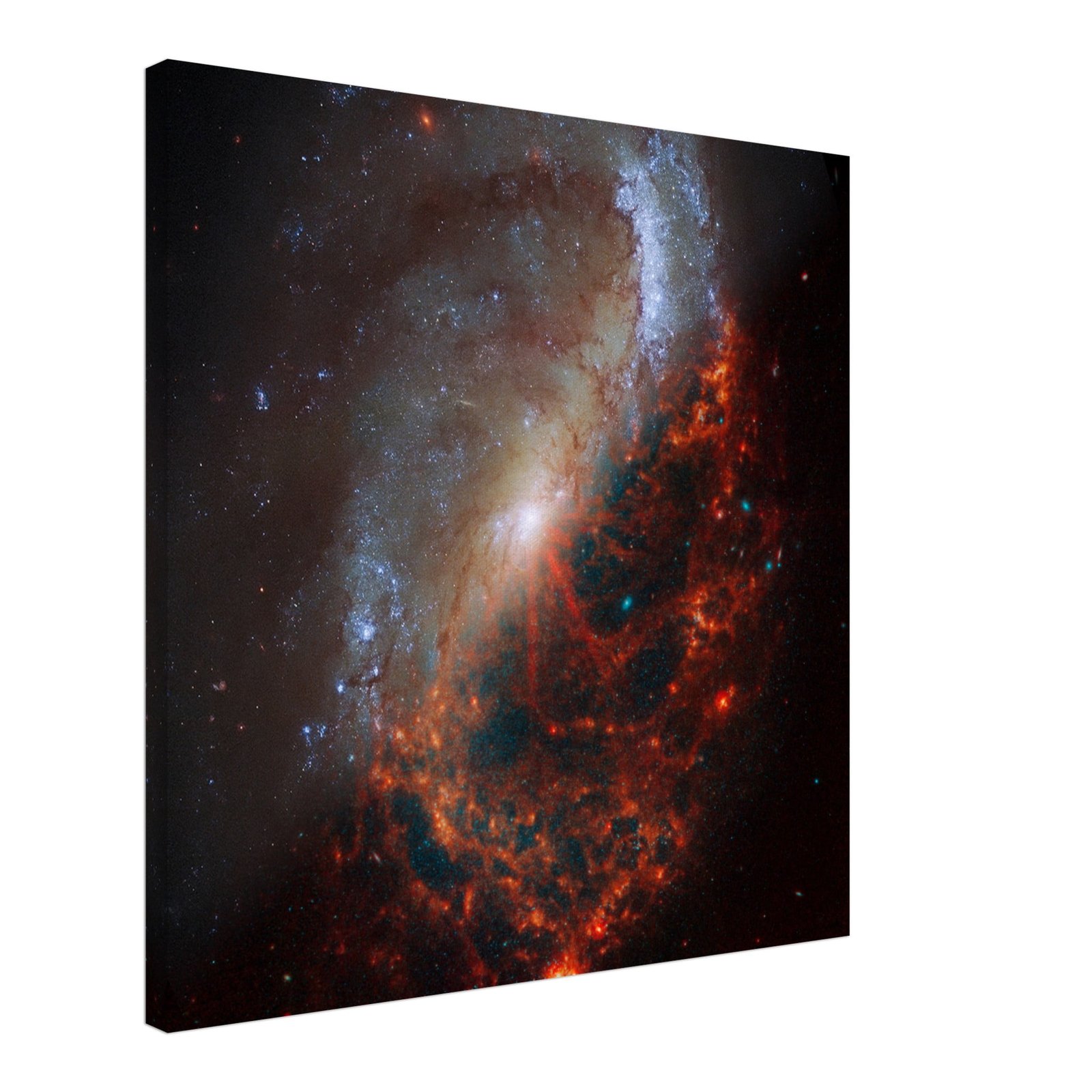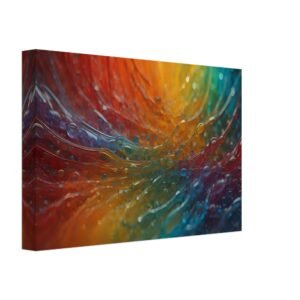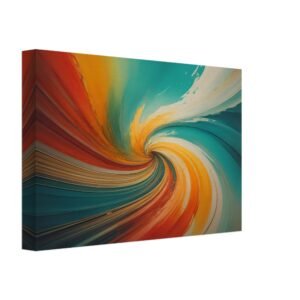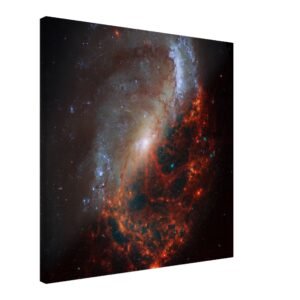The image of the face-on spiral galaxy Mixed Image NGC 7496, is divided diagonally, with the observations from the James Webb Space Telescope appearing on the bottom right and the Hubble Space Telescope on the top left. The contrasting images from Webb and Hubble showcase a stunning interplay of darkness and light.
This contrast arises from the combination of near- and mid-infrared light in Webb’s observations and the display of visible and ultraviolet light in Hubble’s images. Dust within the galaxy absorbs ultraviolet and visible light and then emits it in the form of infrared light. In Webb’s images, we witness the glowing of dust in infrared light. Whereas in Hubble’s images, dark regions indicate areas where starlight is absorbed by dust.
Gas and Dust
In Webb’s high-resolution infrared images, the gas and dust are strikingly visible in shades of orange and red. These images also reveal finer spiral shapes with jagged edges, although these areas still appear diffuse.
In Hubble’s images, the gas and dust appear as hazy dark brown lanes that follow the same spiral shapes. While Hubble’s images have a similar resolution to Webb’s. The gas and dust obscure many of the smaller-scale star formation events.
Bright Central Spikes
In Webb’s images, bright red diffraction spikes at the core of a galaxy can indicate the presence of an active supermassive black hole. As seen in galaxy NGC 7496. However, not all oversized diffraction spikes at galaxy cores are caused by black holes. Sometimes, they appear when numerous intensely bright star clusters are centrally located in Webb’s images.
Hubble’s images, on the other hand, do not exhibit such bright spikes at the cores of galaxies since the cores are not as luminous. Diffraction spikes only occur when the source is exceptionally bright and compact.
Older Stars
In some instances, the central region of Webb’s images emits a blue glow, which indicates high concentrations of older stars. Webb’s infrared observations allow us to peer through the gas and dust and identify these older stars. The light emitted by these aging stars corresponds to the shortest infrared wavelengths in Webb’s images. Hence the assignment of blue color.
In contrast, the cores of Hubble’s images may appear more yellow, creating a soft glow that obscures individual points of light. The presence of hazy brown dust lanes may further obstruct visibility in this area. Older stars in Hubble’s images emit longer wavelengths of visible light, leading to different color assignments.
Younger Stars
In Webb’s image, newly formed stars appear blue along the spiral arms of the galaxies. These blue stars have dispersed the gas and dust that initially surrounded them. The distance from the core determines the likelihood of stars being younger, with stars farther away being more likely to be young. Orange stars, often observed in groups in these images, are even younger and remain enveloped in their cocoons of gas and dust, allowing for ongoing formation.
Hubble’s images exhibit younger stars in shades of blue and purple, which are prevalent throughout the images. In contrast, older stars near the center of the galaxy appear yellowish.
Star-Forming Regions
In Webb’s image, keep an eye out for clusters of bright red and orange, particularly toward the outer edges of the galaxy’s spiral arms. These regions indicate active star formation, with mid-infrared light emphasizing the gas and dust that play a significant role in star formation processes.
Hubble’s images depict star-forming regions as clusters of bright blue and purple, occasionally appearing red and pink as hot stars energize nearby hydrogen gas.
Background Galaxies
Webb’s image showcases distant galaxies located beyond the tightly cropped foreground galaxy. Look for bright blue and pink disks, some seen edge-on resembling a plate with a central sphere. Redder galaxies indicate greater distances.
In Hubble’s view, distant galaxies often appear light orange if they are slightly closer, while deeper red hues indicate greater distances.
Galaxy NGC 7496 was observed as part of the Physics at High Angular resolution in Nearby GalaxieS (PHANGS) program, a comprehensive project that involves observations from various space- and ground-based telescopes to study different phases of the star formation cycle. The project aims to understand the formation of stars within dusty gas clouds and the energy released during this process, which unveils the intricate structures revealed by Webb’s new images.
NGC 7496 is located 24 million light-years away in the constellation Grus.
Credits
Image
NASA, ESA, CSA, STScI, Janice Lee (STScI), Thomas Williams (Oxford), PHANGS Team
Enhanced texture and timeless beauty with our canvas print. The canvas texture enhances the image’s natural look and feel, creating a truly immersive art experience.
spiral galaxy Mixed Image NGC 7496 Features:
- We use responsibly sourced wood for stretcher bars. Mainly FSC certified wood, to make our canvas prints, ensuring a long-lasting and high-quality product.
- Our canvas print is available in two thicknesses – slim and thick – to match your preference. The slim canvas has an approximately 2cm /0.8″ thick wood stretcher bar. While the thick canvas has an approximately 4cm /1.6″ thick wood stretcher bar. Both variants come with hanging hardware included for easy installation.
- We use coated fabric, a blend of cotton and polyester, for our canvas substrate. This provides a weight of approximately 300-350gsm/110-130lb cover and a thickness of 350-400 microns. Giving you a sturdy and durable product.
- Please note that colored edges are not supported. However, we assure you that our canvas print is a beautiful, high-quality product that will bring life to any space.
- We’ve also included a hanging kit, which may vary depending on the country of fulfillment.
- To ensure no damage during transportation, we ship our canvas prints in protective packaging and strong boxes.
- Sizes may vary slightly by region. For the US and Canada, the measurement is in inches. While for the rest of the world, it is in centimeters.
- It is printed and shipped on demand. No minimums are required.

